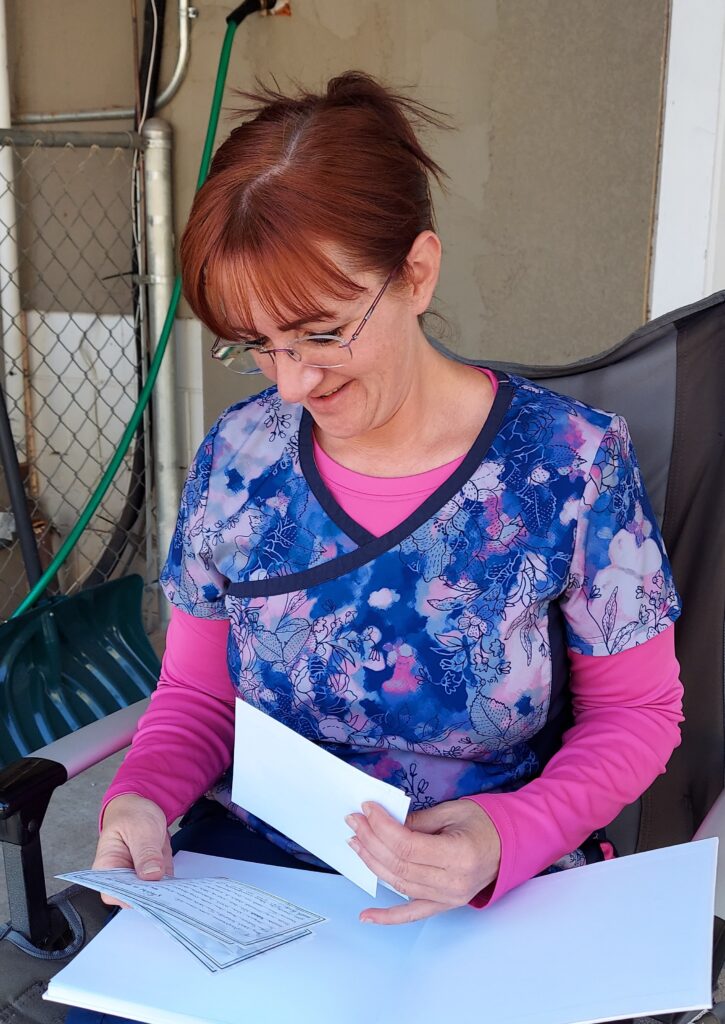Teens Grappling with Gender Identity Most at Risk for Suicide (Part 3)
Thermopolis teen’s death speaks to vulnerabilities, gaps in mental health care system
- Published In: Other News & Features
- Last Updated: Aug 08, 2023

Stephanie Petty celebrates her graduation from Hot Springs County High School in 2022. Less than a year later, she took her own life in April 2023. (Courtesy photo from Tonya Petty)
By Jennifer Kocher
Special to the Wyoming Truth
The following article discusses teen suicide and contains details about those who have taken their own lives. If you are having thoughts of suicide, or are concerned that someone you know may be, resources can be found here.
This is the third story in a series about recent teen suicides in Thermopolis. Check out parts one and two.
THERMOPOLIS, Wyo.– The Ring camera video footage is the last trace Tonya Petty has of her 19-year-old daughter Stephanie.
Sitting in a lawn chair on the porch outside her garden-level apartment in downtown Thermopolis in late July, Petty smiled wanly as she watched the one-minute video on her phone.
In the video, Stephanie paces in and out of the frame with her head down. Her shoulder-length, dark hair is damp and covers half of her face. She walks back and forth, puffing on a cigarette. Her crisp white button-down shirt and matching miniskirt would later take on significance.
At the end of the video, Stephanie stops suddenly and stares into the camera. She then smiles and leans her head again the pole, laughing.
“I wish I knew what was she was thinking,” Petty said, tears pooling in her eyes.
Less than 12 hours later, Stephanie would be dead. She took her own life with a firearm on April 25 in nearly the same spot she was last filmed. Petty found her daughter in the backyard when she came home for her 3 a.m. break from the senior resident facility where she works as a certified nursing assistant.

The white outfit made sense after Petty learned Stephanie had made the rounds that day, saying subtle goodbyes to her friends.
Born a biological male named Logan, Stephanie spent less than a year in her new identity after finally coming out as female at the end of her senior year in high school, Petty told the Wyoming Truth. After spending years questioning her identity, Stephanie seemed to feel comfortable in her own skin, her mother said. But clearly she battled internal demons that she worked hard to hide.
“Stephanie spent her entire life feeling divided,” Petty said. “It must have been exhausting, and she finally gave up.”
Rising trend
Stephanie’s suicide in the small town of roughly 2,725 residents was the second in one month. On April 4, Jordan Christian, 16, also took his own life with a firearm; his mother attributed it to bullying and mental health struggles.
Their deaths are endemic of a rising state and national trend. In Wyoming, teen suicides have increased over the past decade, according to a 2021 report by the Wyoming Department of Health. Between 2010 and 2020, the suicide rate among 10-24 year-olds was 19.7 per 100,000 youths—nearly double the national average.
LGBTQIA+ teens are the most vulnerable demographic when it comes to mental health issues, with 70% reporting increased feelings of sadness and hopelessness, a 2021 Youth Risk Behavior Survey by the Centers for Diseases Control and Prevention found. Among the issues facing LGBTQIA+ youth are bullying and poor mental health, which lead to suicidal ideations and increased suicide attempts.
The Trevor Project, an international nonprofit focused on suicide prevention for LGBTQA+ youth, reported that suicide is the second-leading cause of death among young people age 10 to 24; this demographic is more than four times likely to attempt suicide than their peers.
The extent to which this is a problem in Wyoming is unknown, because the state doesn’t track these numbers, according to Cathy Hoover, program manager for the public health division at the Wyoming Department of Health. Hoover is unable to apply for grants to study or fund programs targeting this demographic, as she lacks the data required for the application.
“I can’t ask questions about it in Wyoming, so it’s really hard for me to prove that it’s a problem,” Hoover said. “The conservative nature of Wyoming puts a lot of barriers to what the state can do, even if it’s best practice nationwide.”
More than a statistic
In speaking publicly for the first time since her daughter’s death, Petty said she doesn’t want Stephanie to be a poster child for transgender rights or a lightning rod in a raging political debate in Wyoming and nationally. Nor does she want Stephanie to be remembered as a statistic or by her means of death.
In sharing Stephanie’s story, Petty hopes to prevent another parent from losing a child to suicide. She also wants people to see her daughter as a unique individual with her own strengths and demons. Above all, Stephanie was funny. A good friend, sister and daughter. A gifted debater and computer programmer who, at age 10, built a working computer with her own hands.
Petty sat in her chair, puffing on a cigarette in the chilly morning air near the spot where her daughter took her life. It’s hard for her to sit out here, but at the same time, it makes her feel closer to Stephanie.
At age 11, Stephanie, then Logan, told Petty and her ex-husband Mark that she felt like a girl. They were caught off guard and advised her to wait a few years to see if she still felt the same way.

“I chalked it up to a phase,” Petty said. “Perhaps that was the biggest mistake I ever made. But didn’t know it was a mistake at the time.”
At the end of her junior year in Hot Springs County High School, Stephanie returned to her parents again with the same request: to transition to female. This time, Petty made an appointment with the family pediatrician, who researched medications and procedures to help Stephanie begin the process of taking testosterone blockers and estrogen. Stephanie also researched gender reassignment surgery in Colorado.
Stephanie hadn’t given any thought to a new name until Petty asked her. Stephanie said she’d never thought she would actually transition and would get back to her. Stephanie it was.
She kept her new identity mostly secret after she began taking hormones. And she did not officially change her name until she came out as Stephanie on her graduation announcement — at Petty’s urging — out of fear of alienating students she had known since childhood. Stephanie did, however, feel comfortable enough to wear a dress to homecoming and prom during senior year; Petty said Stephanie told her that she went mostly unnoticed by her peers.
Meanwhile, Stephanie saw a series of counselors for her anxiety and depression. Most did not help her, Petty believes, because they couldn’t grasp the nuances of Stephanie’s gender dysphoria. Only one seemed to understand, Petty said, but after the therapist canceled two appointments in a row, Stephanie gave up on counseling.
Her mental health issues impacted her ability to do well in school, Petty said. Despite her intellectual capabilities, Stephanie earned B’s and graduated with a 3.5 grade point average.
Part of it, Petty believes, is the fact that Stephanie grew up in the shadow of her older sister, Breeze. In third grade, Breeze announced her plans to graduate high school as valedictorian, which she did. Breeze ultimately gained acceptance to Hamilton College in Clinton, New York.
Stephanie blamed her lackluster grades on her depression. Once, during senior year, Petty asked why she wasn’t completing her assignments and was astounded by Stephanie’s response: “I’m not trying to be rude, but it’s just a fact that I can’t will myself to do anything because my mental health has been in the gutter for the past 12 years of my life, and I’m just tired.”
Petty now gets it: In the aftermath of Stephanie’s death, she finds it hard to get out of bed in the morning. Even showering is a chore.
“And she felt like this every day,” Petty said of her daughter. “It finally became too much.”
When she didn’t get accepted into the computer program at Michigan State University, her first-choice school, Stephanie decided to take a gap year and travel with friends. They left Wyoming last summer for the West Coast, ultimately landing at a free Bureau of Land Management campground in Arizona with hundreds of other nomads, Petty said. Along the way, the group panhandled for food and gas money, with Petty springing for the occasional pizza.
For the first time, Stephanie lived and dressed as a female. And for the first time, Petty said, she seemed to enjoy life based on her messages and phone calls. Six months later, however, the group returned home in early January during a snowstorm. The dreary weather, combined with being back in Thermopolis and at times being misidentified as Logan, seemed to take a toll on Stephanie, Petty said.
Stephanie’s first suicide attempt occurred on February 28 while she was at her father’s house in Thermopolis. She swallowed all of his medication – including Cymbalta, clonazepam and Benadryl – and was taken to the hospital for treatment. On March 2, she was released without a mandatory stay at a mental health facility, Petty said.
Medical records from Stephanie’s 44-hour hospitalization, which Petty provided to the Wyoming Truth, state that Stephanie reported thinking about suicide two to three times per week. She told the attending physician “human connection” is the one thing that would help her no longer feel suicidal, the medical records stated.
In the treatment plan section, there is no mention of next steps to address Stephanie’s self-harm potential—the problem listed in this portion of the medical record. The sentence “We skipped over for time” is all that appears in this section. However, medical records show the attending physician planned to refer Stephanie to a local counselor and noted “there will be a wait unless she calls and announces a crisis.”
Nearly two months later, Stephanie was dead.
Because Stephanie was 19, Petty received the medical records after her daughter’s death. Today, she said she fumes at the lack of follow-up care and her own inability to save her daughter.
Check back for part four, coming soon.













